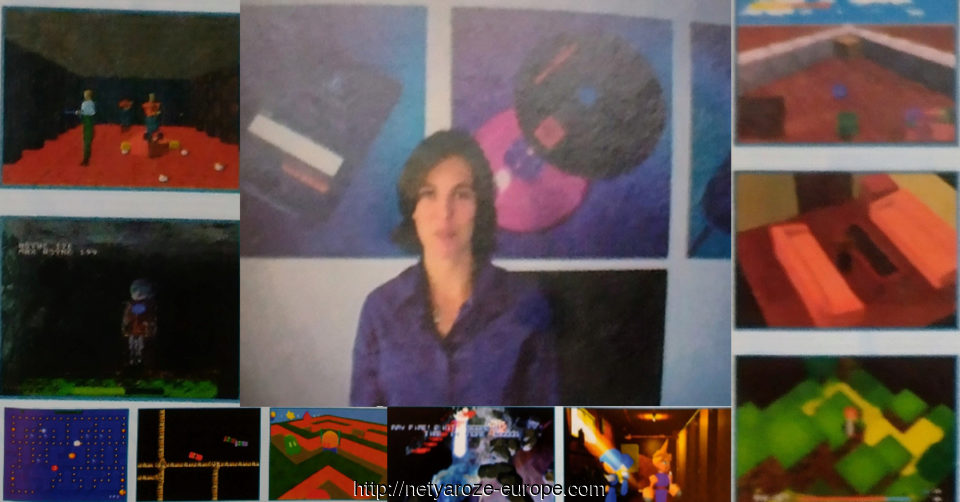
Edge-52-12-97-Net-Yaroze-moves-into-second-gear-and-academia
April 24, 2022, at 03:17 AM (0 comments)
Title: Edge-52-12-97-Net-Yaroze-moves-into-second-gear-and-academia Author: mgarcia Date: 2022-04-24 03:17 +0200 Tags: Media Comments: Open
|  |
Edge issue 52, December 1997 - Pages 126 & 127.
DEVELOP- VIDEOGAME CREATION UNDER THE MICROSCOPE.

Sarah Bennet with other images from the article.
- Text from under the images
- Sarah Bennet, the UK product manager for Net Yaroze, believes that hundreds are using the machine in Britain.
Japanese Yaroze demo's, especially Terra Incognita,(above), are impressively polished.
The power of the Yaroze has yet to be completely harnessed by amateur gamers. However, Japanese hobbyists are obviously getting the gist of things: this shoot'em up (left) and final Fantasy VII spoof (right) reveal real visual finesse.
Many of the demos on Sony's European Yaroze disc, like Manta (left) and Car GI (centre), stick with a 2D perspective. however, some users attempted a simple 3D environment - Like Lars Barstad, with polygonal Pac-Man clone Coneman.
European demos have attempted key genres with a little success. Clone (above) is good.
Net Yaroze moves into second gear - and academia.
In the late '80s, it looked as though the bedroom programmer was facing extinction. The 16bit consoles dominating the industry were closed systems, their expensive dev kits available only to officially licensed developers. At the same time the PC was becoming an increasingly complex platform to work on, with massive rendered sequences and FMV cut-scenes replacing gameplay as the most important factors in commercial titles. The solitary coders who had beavered away on countless 8bit titles in the confinement of their boudoirs were being pushed to the margins of the industry as unloved and irrelevant hobbyists.
Enter Sony, however, and with it change. Not only did the company create the PlayStation, one of the most commercially successful pieces of videogame hardware ever but its designer Ken Kutaragi also made the decision to develop a reasonably priced programmable version of the machine for hobbyist coders. The aim was to encourage anyone with knowledge of C (programming language) to have a go at game development, to create demos, and to swap information and files over the Internet via a dedicated Yaroze website. This was not just a philanthropic endeavour, however. Sony realised there was masses of untapped potential within the amateur programming sector which was being excluded from mainstream development. Encouraging these individuals to develop for the PlayStation was a means of securing fresh talent and new ideas for the machine which perhaps could not have appeared through the rigorous market-testing of the major publishers. Game programming was coming home.
Six months ago the machine was released in Europe, not that many gamers would have noticed. Yaroze - or Net Yaroze as the complete programming package is named - is available via the Internet or through SCE (0171 447 1616) only, and prospective owners have to fill out an application form to become a Net Yaroze 'member'. Membership (which costs €549 (pounds) ) gives users the machine, two CD-ROMs full of software development tools, a serial cable to connect the Yaroze to a PC, and, finally access to the dedicated website.
Over the last few months, the latter has grown significantly. When Edge first reported on Yaroze in (issue) 41, it was not clear how comprehensive the site would be, but now the online meeting place is flourishing, offering technical support, advice, links to dedicated news groups and free web space to members so that they can set up their own pages offering demos and utilities. Plus, although there are several websites for different areas of the globe, all are accessible to members, which means users can swap ideas internationally. And its not only amateurs using the service; Lewis Evans - who provides Yaroze technical support at Sony Computer Entertainment - told Edge that videogame professionals are now buying their own Yarozes and joining in online debates, which no doubt gives wannabe developers invaluable feedback from the 'legitimate' industry.
The big questions are, however, how many people are using the system and how talented are they? Sarah Bennett, the product manager for Yaroze in the UK, reckons there are 'several thousand' Yaroze users worldwide, hundreds of whom are based in Britain, it may not sound like a huge amount, but the machine has had a comparatively modest profile so far, reflecting Sony's insistence that it is a serious programming system rather than a mainstream toy.
The quality of the work, however, is more immediately impressive. Sony has recently compiled two discs full of Yaroze demos - one set from Japan and one from Europe - and both have their moments of potential. It is the Japanese work that shows most promise at the moment: Terra Incognita, for example, is a passable platform RPG with camera zoom and multiple view angles, while Fatal Fantasy VII is a very, very brief - but highly accomplished - dig at Square's masterpiece. The rest of the disc varies between bizarre experiments. Pac-Man clones and scrolling shoot 'em ups, some of which at least resemble proper games.
There are some bright moments on the Europe disc, too. Amongst the limited visual demos is Clone by Stuart Ashley, for example, a first-person shooter which features a believable dungeon environment, scary ambient sound effects and many of the other key elements of the genre (a map screen, locked doors, a strafing facility, etc). The baddies are very rough and the backgrounds are limited, but its a good start along the right road. Also nice to look at are, Lars Barstad's colourful 3D Pac-Man clone, Cone-man, and Ira Rainey's third-person shooter, HSFK, which features very rough but nevertheless recognisable polygon figures. Most seem to have worked more on visual effects or copying well-known genres than working on new gameplay ideas, which is a little disappointing. However, these are early days. Coders will certainly be driven by what Namco proved could be done within the PlayStation's 3.5 megabytes - Ridge Racer.
Regardless of how soon it will be before hobbyists really get to grips with Sony's 32bit box, UK developers certainly seem to be taking notice of Yaroze users. Computer science graduate Scott Evans, for example, was having little luck attracting the attention of games companies until he bought a Yaroze.
'After a couple of busy months learning to code for the PlayStation, I sent my CV to an agency and was expecting to wait several weeks before I heard anything,' he explains. 'To my surprise, one week later I had a couple of job interviews lined up, and later received a firm offer from Code Masters which I accepted.'
And there has been further exciting news for Yaroze users over the last couple of months. Foremost perhaps is the news that Kinetix is now offering 3D Studio 4 to Net Yaroze members for the massively reduced price of £375 (pounds), as well as 2D design package Animator Pro 1.3 for the similarly sublime £175 (pounds). The former is, of course, one of the key 3D design and modelling packages available to industry professionals and, as the Yaroze machine comes with conversion tools, 3DS output can easily be integrated into Yaroze demos. It's an excellent opportunity for those interested in breaking into videogame development to gain vital 3D modelling experience - plus, it's another indication that the software industry as a whole is taking Yaroze seriously.
But potential games programmers who can't afford to splash out on Yaroze needn't worry. Middlesex University is currently building a Yaroze lab at its computer science department - the first of its kind in the country. When finished, the facility will complement the videogame development component of the university's BSc in Applied Computing, and its MSc in Computer Graphics - amongst the first academic qualifications in Britain to feature a videogame design element.
The lab reflects the university's long commitment to computer graphics. As Dr Peter Passmore, programme leader for graphics in the school of computing, points out, 'We've been specialising in computer graphics at this university for a long time - both in computer science and also through our centre for electronic arts. We've run an MSc in computer graphics for about ten years now, and past students of that course have gone on to do all sorts of things, including movie special effects, but many have gone into games development.'
Despite this institutional interest, student curiosity about Yaroze was reasonably low at the beginning. 'When Yaroze first came into being at the beginning of last year, Sony asked if some of our MSc students would like to use them for projects,' says Passmore. 'At the time no one was interested, but last year a third year student of mine became a beta tester for Sony and used Yaroze for his MSc project, and it was from there that we decided to build the lab.'
Interestingly, since publicity about the development lab has grown, greater numbers of students are showing interest in the videogame development aspect of the course - a promising sign for the industry.
So, then, since its European inception in February, the Yaroze initiative has gained both a cult following amongst amateur and professional programmers, and serious interest from academic establishments. Although Middlesex currently has the only Yaroze lab in the country, other academic institutions are showing interest in the idea, and more are sure to follow. Away from academia, the example of Scott Evans shows that Yaroze users are sending out a message to game publishers that they are serious about developing console titles and are seriously employable. As practical experience is much more respected in this industry than academic qualifications, Sony's intriguing black machine could well become an invaluable aid to would-be game professionals.
Notes.
Ira Rainey created A Dog Tale, not HSFK, which was created by Colin Adams & Cobra Developments.
The CDROM for this issue is here, but doesn't mention Net Yaroze: https://archive.org/details/EDGEMAGCD3.
Special thanks to Robert August de Meijer for the two images of the article, from which I was able to transcribe them, it's a good article! thanks again. :)
Comments are open.